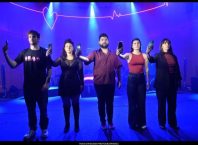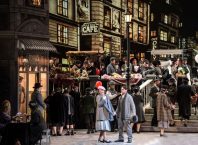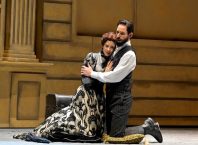When you enter the labyrinth, it’s good to have a ball of thread on hand. Even so, the journey may yet be treacherous, and certainly full of surprises. What if you find yourself at the center of the labyrinth, with only fragmented images of your journey and its culmination, while at your feet, you see several bright threads, each leading in a different direction? That is how it feels to write about the 24-hour experience that is Jan Fabre’s Mount Olympus: To Glorify the Cult of Tragedy, the closing event of the 2016 Israel Festival.
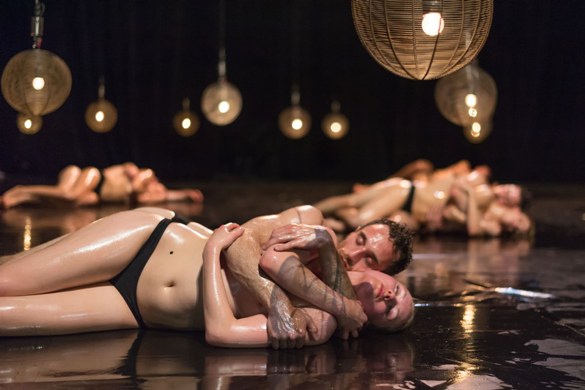
Mount Olympus is a tremendous feat, a work of extremes, excess and contradictions. I am awed by the abilities of the performers. It is a meticulously planned, controlled, and executed work that acknowledges the place of loss of control in our lives, at once reviling and worshiping it. The texts, inspired by Greek tragedy and delivered in English, French, German, and Italian (as far as I could follow) with surtitles in Hebrew, are poetic, concise, moving and meaningful. The music is exquisite, and the costumes – white fabric that is manipulated in myriad ways – are brilliant.
Equipped with my skein of thread (notebook), I took my seat together with the huge crowd that filled the Sherover Auditorium of the Jerusalem Theatre last Thursday, June 9th. Two white robed figures stood onstage as the people kept streaming in. When the auditorium doors closed and the lights went down, I was filled with elation and foreboding in anticipation of this bizarre slumber party with strangers. I had read about Jan Fabre, but never seen a performance – Bravo to the festival’s CEO Eyal Sher and Artistic Director Itzik Giuli for bringing this monumental work to Israel! I had never seen a 24-hour performance before. I was very, very curious. To a certain extent, now, days after the event, I remain curious about many things. The program notes say that Jan Fabre developed Mount Olympus together with the members of his troupe, and it would be interesting to learn more about that process, to what extent the performers were active creators of this work. As for foreboding – what were my fears? An irrational claustrophobia (irrational given that the audience was free to leave and re-enter the auditorium throughout), a fear of boredom and its opposite – a fear of falling asleep and missing something crucial. Those were my thoughts and feelings at the outset, on Friday evening, emerging from the theatre, my only feeling was one of elation.

Opening with an irreverent shocker, a sense of ritual and laughter pervades the entire performance. Two men crawl, fists down apelike towards the two white-robed men who have been standing onstage, and crouching on all fours, each takes his place behind one of the men, who then disrobe. The two now nude, standing men stick out their buttocks, and the crouching men apply their mouths there. The crouching men speak (inaudible to the audience) into the men’s buttocks, and the standing nudes pronounce the words aloud. There is an “ill wind blowing … the snake will uncoil… everything will shake, no escape possible. Nature will show its force. The time has come for us to pay endlessly hopelessly, until the breathing stops, until the city dies until this all will end.” Then the ritual ends as serenely as it began, the men put on their robes – and the audience has a strong intimation of what they (we) are in for.
The performance does not follow a unique narrative arc throughout the 24 hours. There are distinct scenes, each usually focusing on events and characters from a particular play. Dionysus, Hecuba, Oedipus, Jocasta, Iphigenia, Antigone, Heracles, Medea, and other major figures of Greek tragedy have their moment. Movement, music, and visual elements work together with the text to convey character and emotion. While a knowledge of Greek tragedy would enhance the viewing, and certainly alter one’s experience, I did not feel that it was essential. Mount Olympus, I feel, is not so much about any specific story, and offers neither unusual insight or interpretation of Greek tragedy, but is rather about the experience, and the desire to experience.
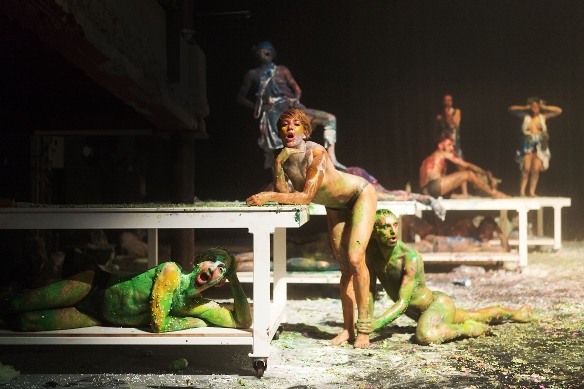
Despite the absence of an explicit narrative arc, one might easily identify recurring themes. Dionysus, his rolls of fat shimmering in a rhythm more sensual than all the hard bodies surrounding him, was master of ceremonies for this evening, intoning and reminding one throughout: “I gave them a tiny bit of madness.” And it is madness, it’s really crazy to have a 24-hour show, and to a certain extent, choosing to participate in this adventure is to choose madness, to choose to relinquish control and let this strange thing happen. All in the very safe confines of the Jerusalem Theatre, of course.
In this sense Mount Olympus creates a contemporary parallel to the theatre of Ancient Greece, a community event in which one might explore and experience moral, emotional, and physical extremes within the framework of ritual. Over the course of the night, for those who chose to remain in the theatre (some people opted to leave for a few hours, sleep in a bed, shower, and return the next day) there was a shared experience of tired bodies. Letting go of convention people slept in the wide halls, young and old, the serious pursuers of cultural peaks and the casual drifters – all became slumbering bodies strewn on cushions and carpets, soft human vessels, dreaming.
It is an intensely self-reflective work, with an awareness of issues of theatre and the philosophical, physical and emotional aspects of a 24-hour performance – whether for the performers or the audience. Many of the texts refer to sleep, the desire for sleep and the desire to remain awake, to experience consciously: “My lack of sleep is a source of dangerous pleasure.”
As one proficient in the art of insomnia, I had hoped to remain far more lucid than I did. There are hours that remain in my mind as isolated images punctuating the darkness, beautiful and disturbing. A human sculpture, bodies moving, shifting, changing, rising into a single, intricate shape. A woman’s head, thrashing in the air, hair flying in a punishing, repeated, gesture that seems to go on forever.
Not every scene aroused my admiration and interest. Ceremonial and meditative, at times the use of repetition felt too tedious, even as a deliberate artistic device. Sometimes, as when Electra played with her pussy, the preoccupation with nudity and sexuality felt redundant on the verge of offensive.
Yet so many of the scenes were profoundly moving and fascinating to observe, even when (because?) they were intensely disturbing. Other scenes were audaciously fun, as when tree hugging was taken to its extreme logical conclusion, or a line of male dancers gave a joyfully sensual interpretation of the Greek traditional Syrtaki dance, penises bouncing. Time and again, the question of exhaustion and endurance were explored in different ways. A military chain-skipping sequence, with the metallic rhythm underscoring the call and response was one of the first stirring instances of endurance, evoking a strong response from the audience, who clapped, as if to encourage the performers to go on despite their fatigue. As the call said: “What is the monster that eats the day? Unused talent and hair turning gray.”
Many hours later, two women (representing Iphigenia and Clytemnestra) performed leaping pirouettes in an endless circle, with Agamemnon at the center. Endless. It was mesmerizing and painful to watch. As they circled, one could observe their individual strategies for persevering: Iphigenia was silent, her focus inward, conserving her strength; Clytemnestra worked large, releasing sound and fury with panache in each leap. Eventually, each, in turn, faltered, and once more the audience responded with applause. Honoring their effort, their sacrifice. Voyeuristically urging them on.
In a work marked by saturation and abundance, the finale was ecstatic worship at the altar of excess. It was an amazing release, a colorful, exuberant, dance and celebration of bodies covered in glitter, paint, and confetti, shouting out: “Now give me all the love you’ve got!” And we did.



